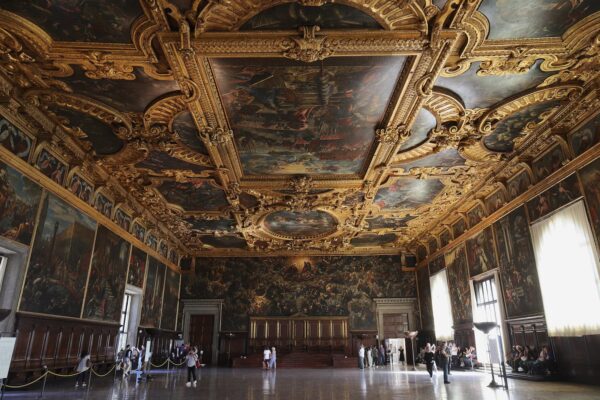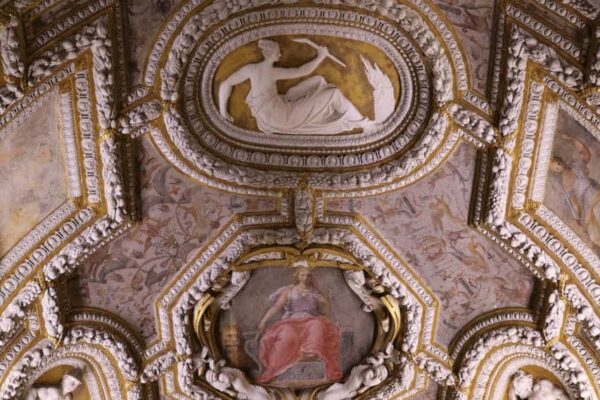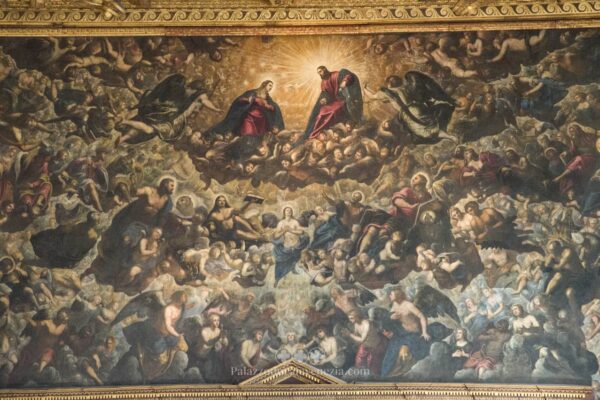The Doge’s Palace houses the works of the most important artists who worked in Venice.
Among the most illustrious who dominated the city’s art scene are the trio of Tintoretto, Paolo Veronese and Tiziano Vecellio, but I cannot fail to mention Vittore Carpaccio, Palma the Younger, Andrea Vicentino and Giambattista Tiepolo.
In this article, for obvious reasons, I will not be able to illustrate every single artwork and author in the palace, but I have decided to choose the authors and paintings that most impressed me and that celebrate the myth of Venice.
Before we begin, a brief preamble: if you plan to visit the Doge’s Palace in Venice, the halls and all the other rooms, it is strongly recommended that you purchase your ticket online, because of the long line that may form at the ticket office. By purchasing the ticket in advance, you will be able to access the Doge’s Palace by skipping the line.
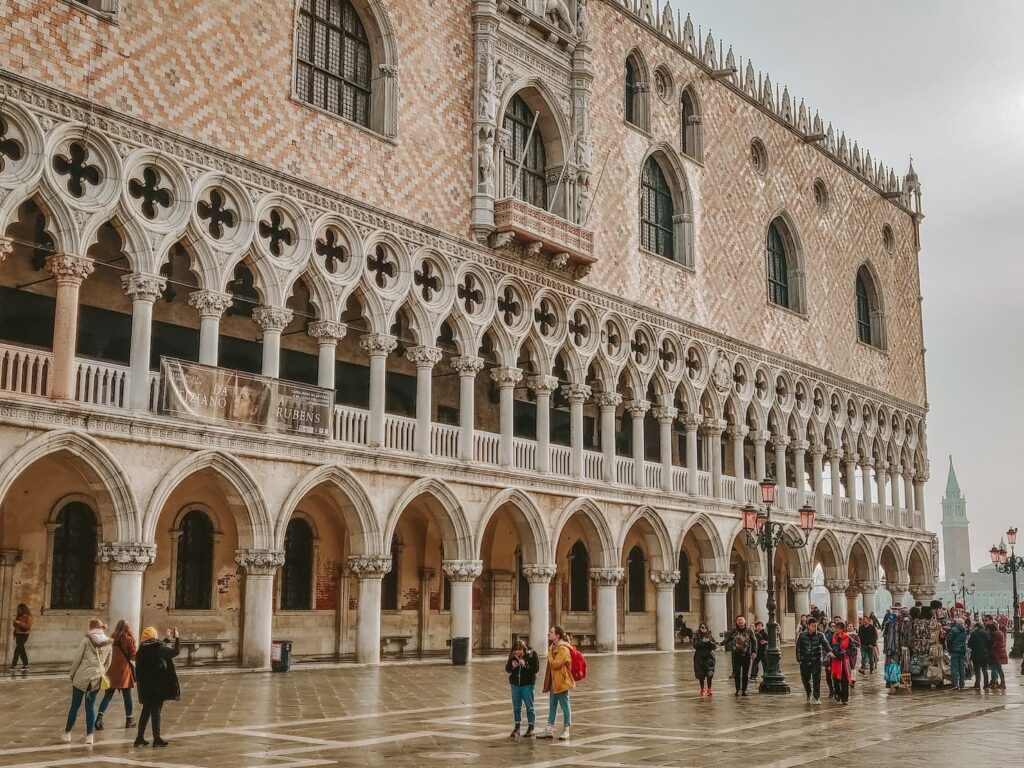
Doge’s Palace Venice skip-the-line ticket: quick access
Buy online. Choose your preferred time. Visit Venice’s Doge’s Palace, Bridge of Sighs, prisons and more.
You can cancel for free up to the day before your visit.
Table of content
- 1 What paintings are in the Doge’s Palace?
- 2 Other paintings in the Doge’s Palace Venice
- 2.1 Scarlatti Hall
- 2.2 Grimani Hall
- 2.3 Erizzo Hall
- 2.4 Hall of the Stuccoes
- 2.5 Hall of Philosophers
- 2.6 Corner Room
- 2.7 Liagò
- 2.8 Armamento Room (or Sala del Guariento)
- 2.9 Hall of the Scrutiny
- 2.10 Chamber of the Great Council
- 2.11 Square atrium
- 2.12 Hall of the Four Doors
- 2.13 Antichamber of College
- 2.14 College Hall
- 2.15 Hall of the Council of Ten
- 2.16 Hall of the Compass
- 3 Frequently asked questions
- 4 Doge’s Palace artworks: conclusions
What paintings are in the Doge’s Palace?
Tintoretto – Paradise painting
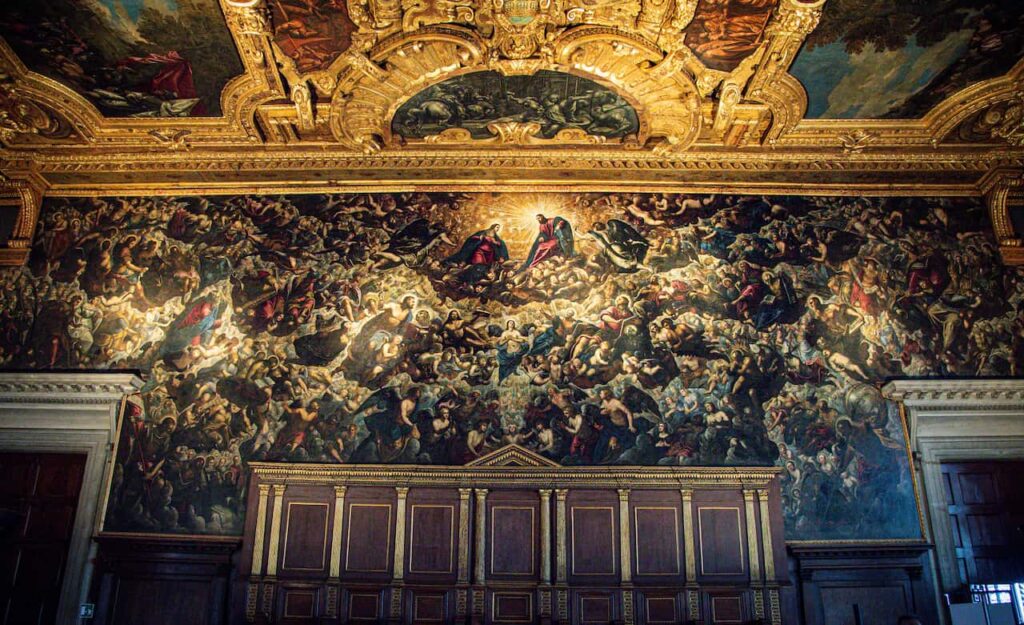
Jacopo Robusti, known as ‘Il Tintoretto’, was born in Venice in 1518 and was one of the greatest exponents of the Venetian school and the Italian Renaissance.
The appellation Tintoretto was derived from the trade of his father, a fabric dyer, who encouraged his artistic talents by having him enter the workshop of the painter Titian.
The use of chiaroscuro with bold contrasts, the revolutionary use of color and the use of bold perspectives are characteristic representational modes of this artist who loved to convey a sense of pathos and drama in his works. His dynamic scenes made the writer Jean-Paul Sartre say that Tintoretto was ”the first director history has ever had”.
At the end of the Great Council Chamber is his colossal painting of Paradise, painted between 1588 and 1592.
The canvas is composed of several stitched canvases and is populated by a multitude of figures of saints and angels (about five hundred), the vision, despite representing paradise, is unexpectedly chaotic and crowded, almost gloomy. At first impact it conveys a feeling of horror vacui, were it not for the light that pervades the two protagonists of the scene, Jesus and Mary, supported by a dense array of cherubim and seraphim.
The beam of light descending below them is the holy spirit falling exactly on the tympanum of the throne on which the doge sat and announcing favours to the Republic from Christ.
The theme is not only religious but also an allegory of Good Government, the light is the divine essence that enters the figure of the doge, invested with a celestial mission, enabling him to always make the right decision.
The painting is populated by numerous characters recognizable by their symbols:
An angel in flight offers Mary a flower, it is the Archangel Gabriel handing the Annunciation Lily; below the protagonists are represented the four evangelists : St. Mark with the Lion, Luke flanked by the Ox, Matthew with the Angel and John with the Eagle; on the right are the twelve apostles, Adam and Eve, Abraham with his little son Isaac, King David playing the psaltery, Moses with the tablets of the law, Noah with the model of the ark; then the prophets with open books and the doctors of the church are recognizable; the martyrs are portrayed in large numbers with palms in their hands.
In the realization of the painting, which was described by Ruskin as ”the most beautiful in the history of art”, the painter, no longer a young man, collaborated with his son Domenico, leaving us one of the last and most spectacular works by this artist, whose numerous paintings lent beauty to the palaces of Venice.
Paolo Veronese – the Triumph of Venice
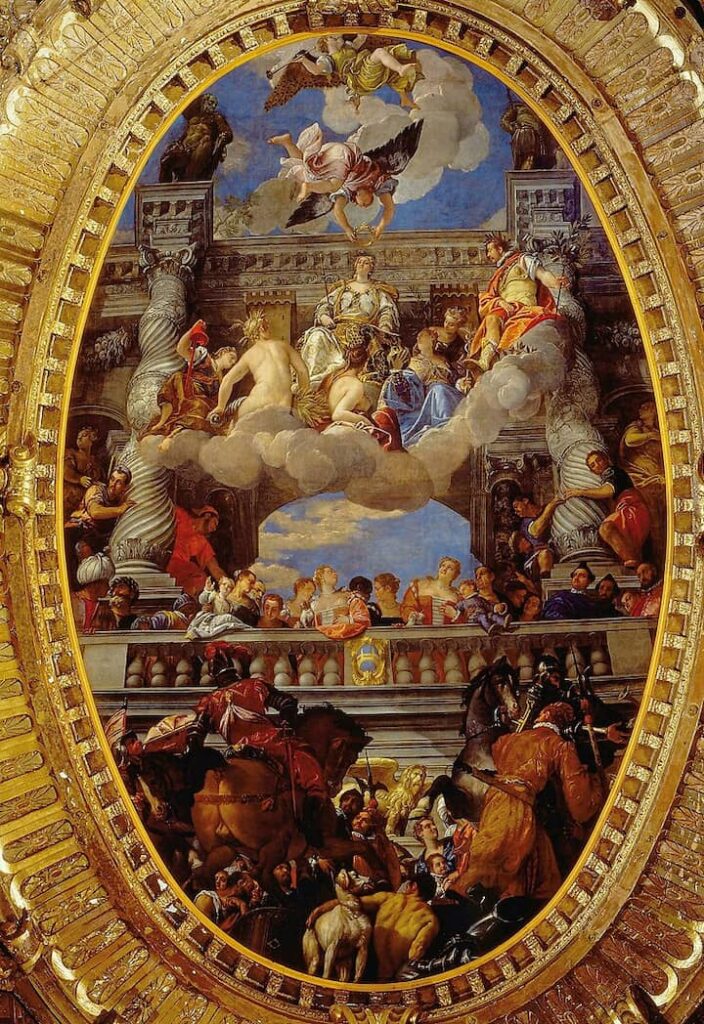
Paolo Caliari, nicknamed ‘Il Veronese’, was born in Verona in 1528.
In 1553, the artist was first called to work in Venice with a prestigious commission: the decoration of the new rooms in the Doge’s Palace for the Council of Ten. The patrons were so satisfied with his work that they later commissioned him to paint cycles in other rooms of the Palazzo.
The fame of this great artist derives from his skills as a colorist. This painting technique, typical of the Venetian environment, involved applying color to the support without having previously made a preparatory drawing, thus defining the figures. This procedure allowed the artist to use color and shape the effects of light with greater freedom. Colorism was to be one of the currents that later inspired Impressionist painters from the second half of the 19th century, including Renoir.
Among the works by Veronese in the Doge’s Palace, I have decided to describe one of my favorites, the ‘Triumph of Venice, Crowned by Victory’.
This canvas, painted by Veronese in 1583, occupies the oval space in the center of the wooden ceiling of the Hall of the Great Council.
One of the characteristics of this artist is to make the observer’s eye lose itself among a multitude of characters, who ”move” dynamically within complicated and theatrical architecture, with optical illusions and perspective inventions. The painting is clear and bright, depicting the city of Venice in the guise of a queen with golden hair. The top of the painting is occupied by the figure of Winged Victory crowning Venice, while at her feet are depicted Peace, Abundance, Glory, Security and Liberty. Leaning against the balustrade below is a representation of all Venetian society, from the people to the patrician class, who, guarded by guards on horseback, celebrate their city.
It is interesting to lose oneself in the symbols that can be found within the painting, if one observes among the figures of the people that a soldier caresses a white dog, symbol of Loyalty.
Vittore Carpaccio – the Lion of St Mark
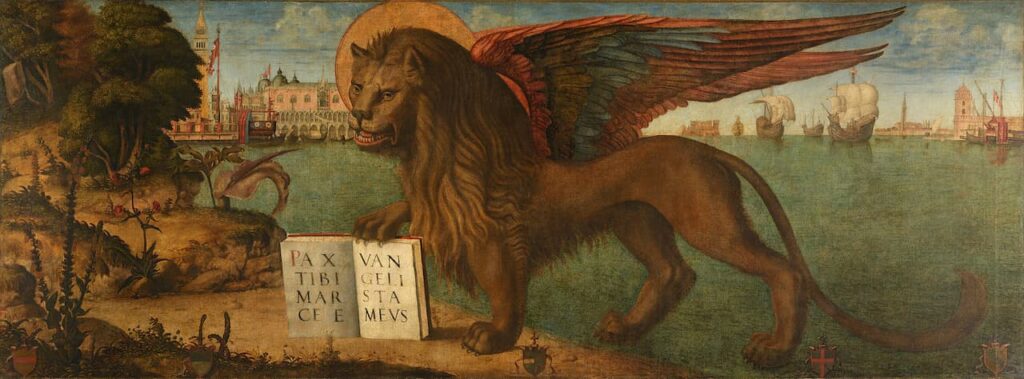
Vittore Carpaccio was born in Venice in 1465. He distinguished himself by producing “teleros” depicting Venetian society at the turn of the 15th and 17th centuries, with its customs and traditions.
Telero was a painting technique that involved the use of large canvases, usually made of hemp or linen, which were mounted on wooden supports and painted with oil colors. This technique was widely used in Venice due to the difficulty of preserving frescoes in such humid climates.
One of Carpaccio’s particularities was his vast knowledge of courtly romances, poems, bestiaries, classical art, heraldry and hagiography from which the figures and details that populate the landscapes and glimpses of his canvases are inspired.
One of his most famous works is the tempera painting of the Lion of St. Mark, painted in 1516.
The winged Lion of St Mark is the symbol of the Republic of Venice and represents the patron saint of the city. Christian legend has it that while sailing through the waters of Aquileia towards Rome, an angel in the guise of a lion appeared in a dream to the evangelist exclaiming the phrase ‘Pax tibi Marce Evangelista meus, hic requiescet corpus tuum” (Peace to you Mark my Evangelist, here shall your body rest), foretelling that the saint would find glory and rest among the Venetian people.
In this painting you will notice, as in other representations of the Venetian lion, that the animal holds an open book with the traditional inscription in its claws.
The front paws of the lion, depicted in motion rest on the land, while the rear paws rest on the water, an obvious reminder of the Republic’s dominion over land and sea.
In the background is a magnificent view of Venice with its Doge’s Palace, the Basilica and St Mark’s Bell Tower. On the right is a view of the Arsenale and the Punta della Dogana, with vessels passing over the waters of the lagoon.
This painting was originally commissioned by five magistrates of Dazio de Vin, to whom the coats of arms you can see at the base of the painting belong, and was placed in their palace on the Riva del Ferro. The painting was later moved to the Sala Grimani in the Doge’s Palace in 1797.
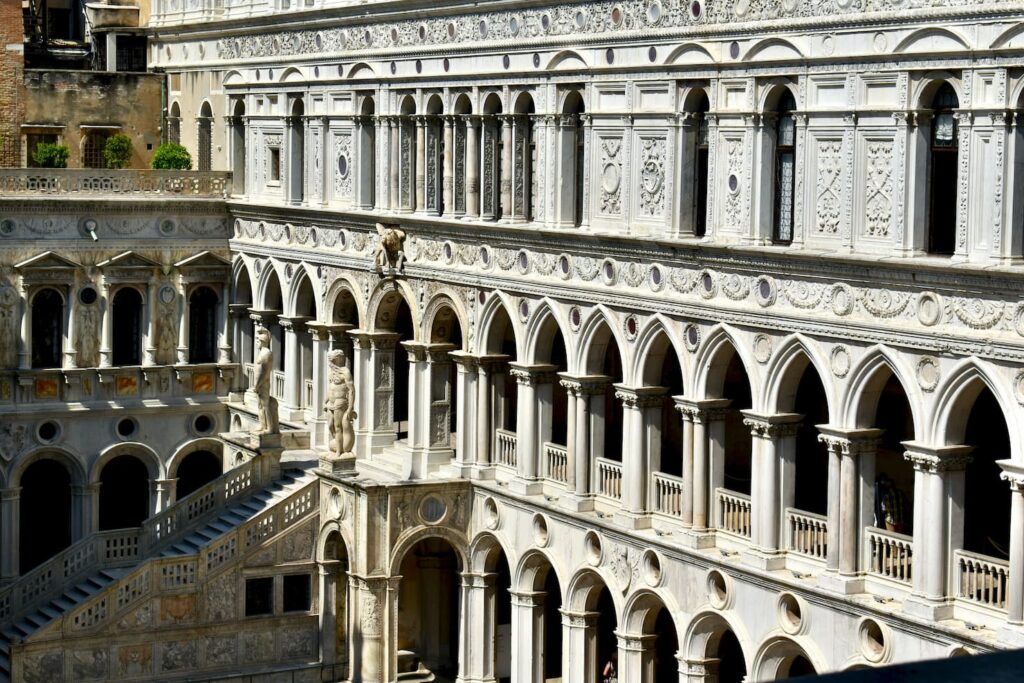
Doge’s Palace Venice skip-the-line ticket: quick access
Buy online. Choose your preferred time. Visit Venice’s Doge’s Palace, Bridge of Sighs, prisons and more.
You can cancel for free up to the day before your visit.
Andrea Vicentino – the Battle of Lepanto
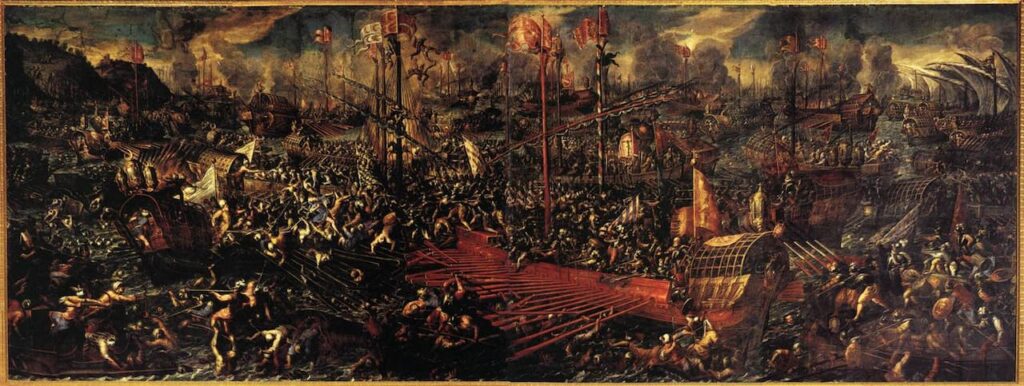
Andrea Michieli, known as Il Vicentino from his city of birth, was one of the most prolific artists in Venice. The mannerist artist trained in the orbit of Tintoretto, Veronese and Bassano. He was involved in the major rebuilding of the pictorial decoration of the fire-ravaged rooms of the Maggior Consiglio and Scrutinio.
At the Doge’s Palace you can admire one of the most spectacular of his paintings, ‘The Battle of Lepanto’.
The work was first commissioned to Tintoretto by the Council of Ten to celebrate the memorable battle against the Turks on 7 October 1571, but the painting was destroyed in a disastrous fire in 1577.
The new canvas, commissioned from Veronese, amazes us with the minuteness of the details and the number of characters that animate the scene and render well the idea of what was the battle that saw the greatest concentration of warships ever seen in that stretch of sea. Chronicles narrate that an army of 244 warships, the famous galleys and galeas, and 90 thousand soldiers and sailors were employed.
The painting is so detailed that we can make out some of the protagonists of the battle. In the foreground on the right is the future doge Sebastiano Venier, dressed in black and with a white beard, the commander of the allied Spanish army John of Austria (you can recognize him by the Spanish plumed helmet and the scepter of command in his hands), and of the papal army Marcantonio Colonna waving the banner with Christ on a golden background. In the center of the left side is the Ottoman Admiral Ali Pasha.
Palma the Younger – the Last Judgement
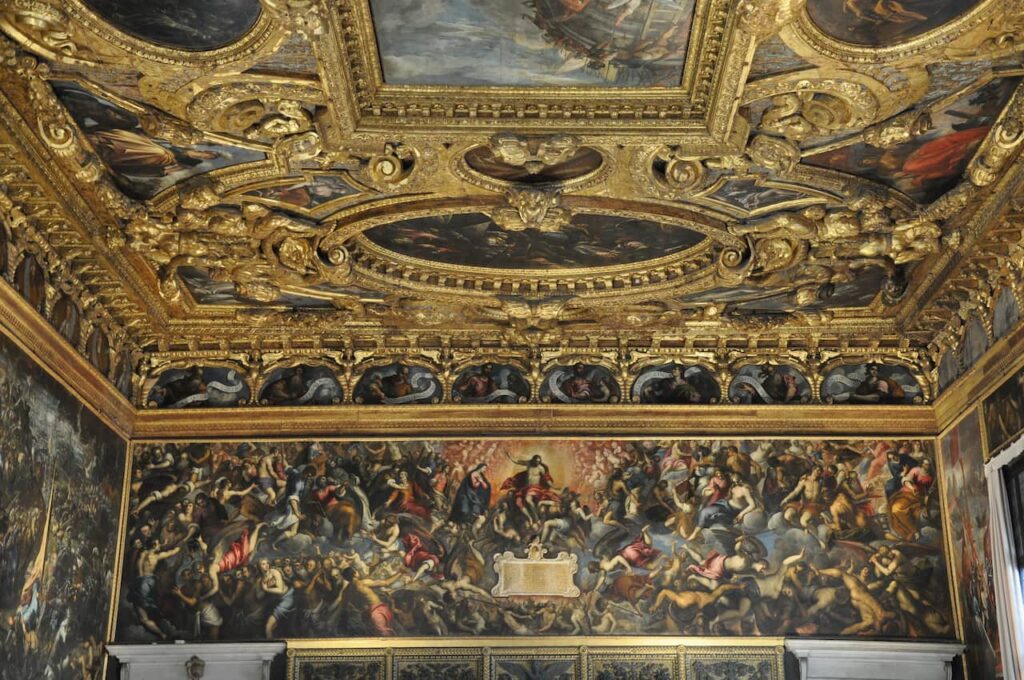
Jacopo Negretti, known as Palma the Younger to distinguish him from his great-uncle Jacopo, was born in Venice in 1549.
His style was influenced by that of Titian, Tintoretto and Veronese.
In the Hall of the Scrutiny, in 1592, Palma the Younger painted the enormous telero of the Last Judgement.
The choice of the theme is not accidental, in fact in this room the scrutiny of the votes that were held in the Hall of the Great Council took place. The painting is therefore an allegory of the exercise of Justice and the rejection of vices. The painting is preparatory to Tintoretto’s Paradise, which decorates the subsequent Great Council Chamber.
The protagonist of the scene is the figure of Jesus, invested with light, as he descends from empyrean surrounded by angels and angelic choirs.
In his descent Christ pronounces the words of judgement, blessing the elect with one hand and rejecting the damned with his left hand.
At his side are Mary and the apostle John, while in the background is the host of the twelve apostles.
Four pipe angels sound the trumpets that bring the dead to awakening, represented at the moment of their resurrection, under a tombstone.
On the left is the procession of the blessed while on the right is the procession of the condemned, driven away by angels and welcomed by the devils of hell.
Giambattista Tiepolo – the Gifts of the Sea
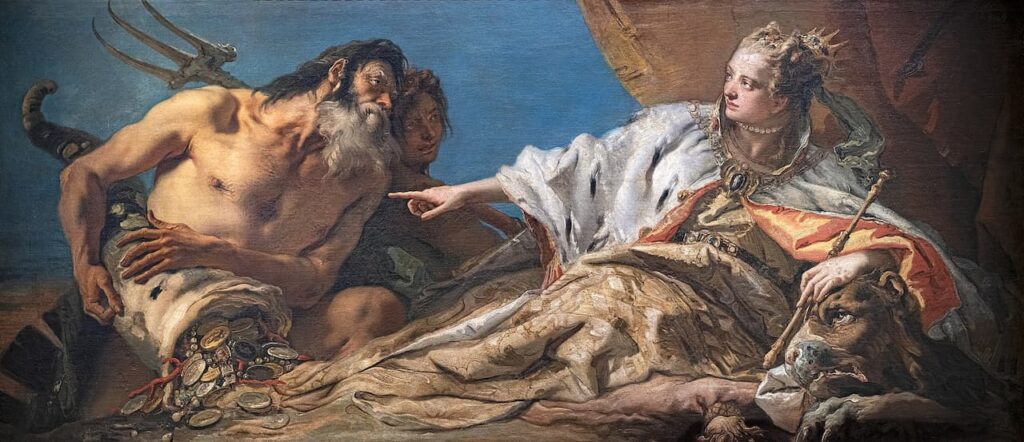
Tiepolo is famous for being one of the most ‘internationally’ sought-after artists during the time of the Republic. Numerous princes, sovereigns and prelates in Europe, Russia and Spain commissioned the painter to decorate their palaces.
The artist was born in Venice in 1696 and is considered one of the greatest exponents of the Rococo style. His style is recognizable by the spectacular nature of his paintings, with illusory spaces breaking through the vaults and luminous spaces created by the use of light and transparent colours. The works are often populated by mythological figures and allegories, as well as people and animals from faraway and exotic places.
Inside the Hall of the Four Doors you can admire the only painting Tiepolo made for the Doge’s Palace in 1758, ‘Neptune offering gifts to Venice’.
The work reproduces an earlier work by Tintoretto, now too degraded to be preserved.
The subject features Neptune and Venice: the God of the Seas pours from a cornucopia a multitude of gifts: gold coins and jewelry including pearls and coral, i.e. all the riches the city earned from its flourishing trade.
Venice is depicted as a beautiful woman in 16th century dress, resting one arm on the symbol of her power, the winged lion of St. Mark.
Although the painting celebrates the myth of Venice, the city’s dominance over the Levant was by then reduced to small islands and its trade was no longer as flourishing as it had been during the Renaissance.

Doge’s Palace Venice skip-the-line ticket: quick access
Buy online. Choose your preferred time. Visit Venice’s Doge’s Palace, Bridge of Sighs, prisons and more.
You can cancel for free up to the day before your visit.
Other paintings in the Doge’s Palace Venice
As I specified earlier, this article does not cover all the numerous paintings on display in the Doge’s Palace, but I will provide you with a list of the most important works housed in each room, which you can take with you as you stroll through the rooms of this magnificent building.

Scarlatti Hall
- Madonna and Child, Titian
- The Resurrection, Giuseppe Porta
- The Doge Loredan with St Mark in Adoration of the Virgin and St John the Baptist, Vincenzo Catena
Grimani Hall
- The Triumph of Marcus Aurelius; Jacopo Tintoretto
- The Triumph of Constantine; Veronese
- The Triumph of Tiberius; Titian
- The Triumph of Hadrian; Jacopo Tintoretto
- The Triumph of Nero; Jacopo Tintoretto
- The Triumph of Vespasian; Jacopo Tintoretto
- The Triumph of Domitian; Jacopo Tintoretto
- The Triumph of Antoninus Pius; Jacopo Tintoretto
- The Triumph of Caracalla; Jacopo Tintoretto
- The Triumph of Trajan; Jacopo Tintoretto
Erizzo Hall
- Doge portraits; anonymous artists
- The Ascent to Calvary; Girolamo Bassano
- Noah’s Ark; Girolamo Bassano
- The Presentation in the Temple and an 18th-century canvas depicting Doge Sebastiano Ziani before Pope Alexander III; Girolamo Bassano
Hall of the Stuccoes
- Portrait of Henry III; Tintoretto
Hall of Philosophers
- Depictions of ancient philosophers; Paolo Veronese
- Saint Christopher with the Child on his Shoulders; Titian
Corner Room
- Madonna Enthroned with Child; Alvise Vivarini
- The Praying Virgin; Giottesque School
- Lamentation of Christ; Giovanni Bellini
Liagò
- The Seafarer offers a model of a galley to Santa Giustina; Domenico Tintoretto
- The Transfiguration; Domenico Tintoretto
- Doge Giovanni Bembo before Venice with allegorical figures; Domenico Tintoretto
- The Doge Marcantonio Memmo before the Virgin with symbolic figures of subject cities; Jacopo da Palma Il Giovane
- Religion; Jacopo da Palma The Younger
- La Concordia; Jacopo da Palma Il Giovane
Armamento Room (or Sala del Guariento)
- The Coronation of the Virgin enthroned next to the Redeemer; Guariento
This 14th-century fresco, the remains of which were found in 1905 below Tintoretto’s Paradise, was removed and relocated inside the Armamento Room. The reason the painting was replaced was the great fire that destroyed the Palace on 20 December 1577. The work represents the Coronation of the Virgin Mary.
Hall of the Scrutiny
- The Last Judgement; Jacopo da Palma Il Giovane
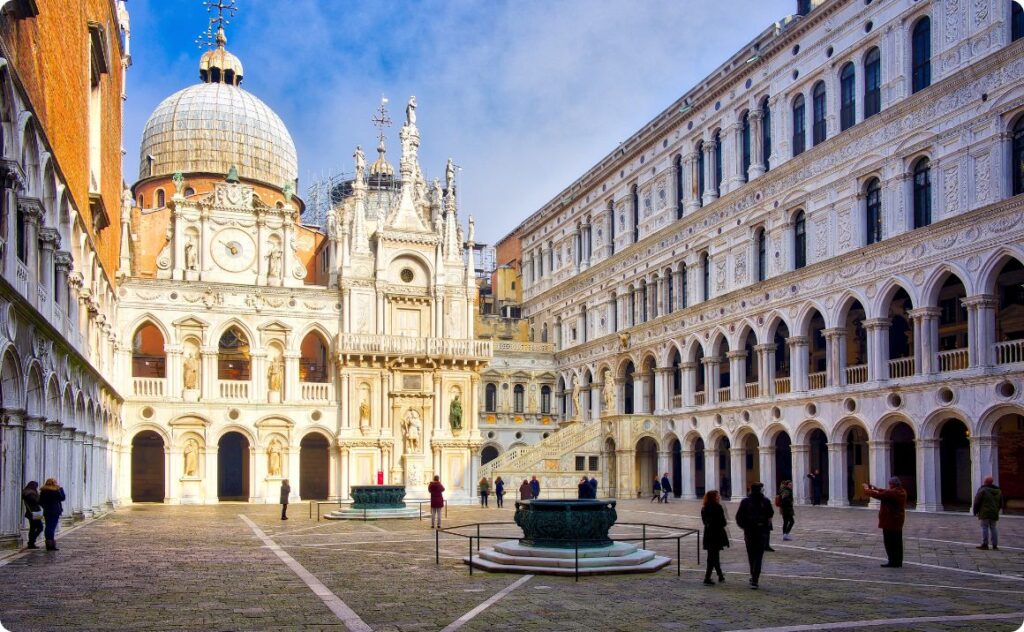
Doge’s Palace Venice skip-the-line ticket: quick access
Buy online. Choose your preferred time. Visit Venice’s Doge’s Palace, Bridge of Sighs, prisons and more.
You can cancel for free up to the day before your visit.
Chamber of the Great Council
- Coronation of the Virgin Mary; Guariento
- Triumph of Venice; Paolo Veronese
- Doge Nicolò da Ponte, in the presence of Venice, receives the homage of the ambassadors of the subject cities; Jacopo Tintoretto
- The Paradise; Jacopo and Domenico Tintoretto
- Venice crowned by Victory welcomes the subject provinces; Jacopo da Palma il Giovane
- Portrait of Doge Andrea Dandolo; Tintoretto
- The Taking of Smyrna; Paolo Veronese
- The Defence of Scrutari; Paolo Veronese
- The Battle of Casalmaggiore; Francesco Bassano
- The battle of Polesella; Francesco Bassano
- The battle of Riva; Tintoretto’s workshop
- The battle of Argenta; Tintoretto’s workshop
- The defence of Brescia; Tintoretto’s workshop
- The battle of Gallipoli; Tintoretto workshop
- The battle of Maclodio; Francesco Bassano
- The battle of Cadore; Francesco Bassano
- The victory of Cremona; Jacopo Palma
- Andrea Gritti reconquers Padua; Jacopo Palma
- Pope Alexander III delivers the sword to the doge Sebastiano Ziani; Francesco Bassano
- The conquest of Zara; Andrea Vicentino
- The taking of Constantinople; Domenico Tintoretto
- The victory over the Genoese at Chioggia; Carlo and Gabriele Caliari
Square atrium
- Eight side canvases with biblical episodes and putti symbolising the seasons; Jacopo Tintoretto
- The Announcement to the Shepherds; Girolamo Bassano
- and three canvases attributed to Veronese, Adam and Eve Banished from Paradise; Il Veronese
- The Prayer in the Garden; The Veronese
- Saint John writing the Apocalypse; The Veronese
Hall of the Four Doors
- Personifications of Venice and cities subject to it (Verona, Brescia, Istria, Padua, Friuli, Treviso, Vicenza, Altino); Jacopo Tintoretto
- Jupiter gives Venice dominion over the Adriatic; Jacopo Tintoretto
- Juno offers Venice the insignia of power; Jacopo Tintoretto
- Venice breaks the yoke of slavery; Jacopo Tintoretto
- Neptune offers gifts to Venice; Giambattista Tiepolo
- Venice leaning on the world; Nicolò Bambini
Antichamber of College
- Venice dispenses riches and honours; Paolo Veronese
- Mercury and the Graces; Jacopo Tintoretto
- Pallas drives away Mars; Jacopo Tintoretto
- Arianno found by Bacchus; Jacopo Tintoretto
- Vulcan’s Forge; Jacopo Tintoretto
College Hall
- The Triumph of Venice; Domenico Tintoretto
- The Dead Christ Adored by Doges Pietro Lando and Marcantonio Trevisan, Jacopo Tintoretto and workshop
- Doges Lorenzo and Girolamo Priuli in Adoration of Christ Triumphant; Palma il Giovane
Hall of the Council of Ten
- The Adoration of the Magi, Antonio Aliense
- The Peace of Bologna between Charles V and Clement VII in 1530; Marco Vecellio
- Copy of Jupiter descending from heaven to strike down the vices; Veronese
- Old Oriental; Il Veronese
- Juno scattering her gifts over Venice; Il Veronese
Hall of the Compass
- 19th-century copy of St. Mark Crowning the Theological Virtues by Paolo Veronese
Frequently asked questions
The Doge’s Palace in Venice contains a complete compendium of the history, politics, art and institutions of the Venetian Republic.
The Palace was the residence of the Doge. As soon as he was elected, the head of state was obliged to ‘move’ into the flats reserved for him: some 20 rooms, a private chapel and a library.
Inside the Palace, besides the rooms of the main governing bodies of the Venetian Republic, you can admire a rich artistic and sculptural heritage commissioned and collected for centuries by its doges. Among the most famous works are Tintoretto’s Paradise, Vittore Carpaccio’s Marcian Lion and Jacopo Sansovino’s statues of Mars and Neptune.
The Palace is famous for its fascinating Venetian Gothic architecture, for the richness of the artistic heritage housed within it and for the historical and symbolic value that the building possesses. In fact, it housed the most important representative bodies of the Venetian Republic and the Doge’s flats.
The palace was restored and enlarged at the behest of Doge Sebastiano Ziani starting in 1173. Later, numerous extensions and reconstructions were commissioned over the centuries by the doges of the Venetian Republic to the most illustrious architects including Nicolò Barattiero, Filippo Calendario, Antonio Rizzo, Pietro Lombardo, Antonio Abbondi, Antonio da Ponte, Andrea Palladio, Gianantonio Rusconi and Bartolomeo Manopola.
Numerous artists painted the rooms and adorned them with their canvases. Among the most illustrious were Guariento, Jacopo and Domenico Tintoretto, Paolo Veronese, Tiziano Vecellio, Vittore Carpaccio, Palma il Giovane ,Girolamo Bassano, Andrea Vicentino and Giambattista Tiepolo who painted the interior of the Doge’s Palace.
Doge’s Palace artworks: conclusions
Here we are at the end of this article on the paintings of the Doge’s Palace in Venice, if you would like to know more, do not hesitate to write to us!
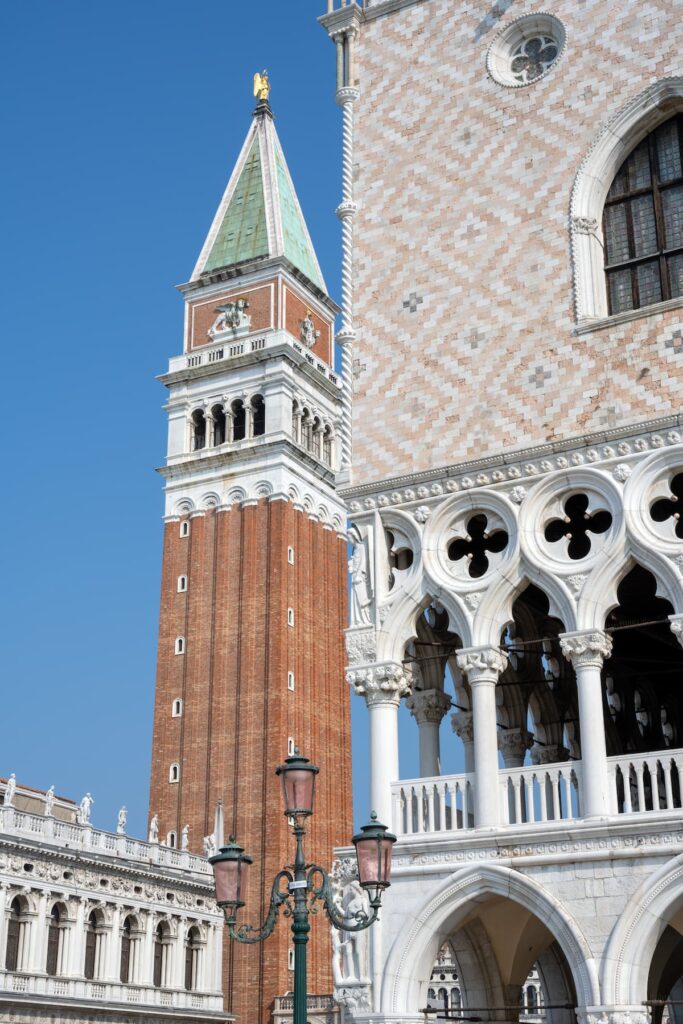
Doge’s Palace Venice skip-the-line ticket: quick access
Buy online. Choose your preferred time. Visit Venice’s Doge’s Palace, Bridge of Sighs, prisons and more.
You can cancel for free up to the day before your visit.
Photo credits
- Paradiso di Tintoretto: Foto di Erik Törner via Flickr
- Trionfo di Venezia: Foto via Wikimedia
- Leone Marciano Andante: Foto via Wikimedia
- Battaglia di Lepanto: Foto via Wikimedia
- Giudizio Universale: Foto di Ryan Hadley via Flickr
- Omaggio di Nettuno: Foto via Wikimedia
- Sala del Consiglio dei Dieci: Foto di Mustang Joe via Flickr
